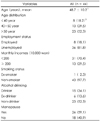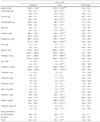Abstract
This study investigated the effects of the nutrition education and exercise program on body composition, dietary intakes and physical fitness in obese women. The subjects were 44 obese women (BMI≥ 25 kg/m2) who had been participating in nutrition education (1 time/week) and exercise program (3 time/week) for 12 weeks. Nutrition education was focused on low energy, high protein and low carbohydrate diet to reduce the body weight and improve the diet quality. To evaluate the effectiveness of the program, daily nutrient intakes were assessed by 24-hour recall method. Body composition, blood lipid profiles and physical fitness test were assessed before and after the intervention. After the intervention, body weight, BMI, percent body fat, soft lean mass and waist/hip ratio were significantly decreased (p < 0.001). Fasting blood sucrose, total cholesterol, LDL-cholesterol and atherogenic index (AI) were significantly decreased (p < 0.001), while HDL-cholesterol was significantly increased (p < 0.001). Energy adjusted protein, fiber, vitamin A, vitamin B2, vitamin B6, vitamin C, vitamin E, niacin and folate were significantly increased. After the intervention, the muscle endurance, muscle strength, agility, balance were significantly increased. The changes in obesity indices (body weight, BMI, percent body fat, waist-hip ratio) were correlated with the changes of the nutrient intakes, serum lipid profiles, physical fitness. These results show that nutrition education and exercise program was effective not only for weight reduction but also for the improvement of physical strength and cardiovascular disease risk factors in obese women.
Figures and Tables
Table 3
Change of anthropometric parameters, blood pressure and serum lipid profiles in the subjects according to intervention

References
1. Jeon ER. Effect of nutrition education and aerobic exercise program on weight control program of middle aged abdominal obese women. Korean J Human Ecol. 2006. 9(2):65–73.
2. Jung YJ, Shin JH, Yeom KS, Song CH, Choi HS, Kim KS, Park JH. Association between obesity indices and physical fitness. J Korean Acad Fam Med. 2003. 24:271–278.
3. Baek YA, Kim KN, Lee YA, Chang NS. The effects of nutrition education on visceral fat reduction and diet quality in postmenopausal women. Korean J Nutr. 2008. 41(7):634–644.
4. Ministry of Health and Welfare. The Third Korea National Health & Nutrition Examination Survey (KNHANES III) 2007 Nutrition Survey. 2007.
5. Lee ES, Son TY. Effect of sports dance activity on obesity and insulin resistance-related markers in post menopausal women. J Korean Sport Med. 2008. 26(2):214–223.
6. Jeong SK, Seo MW, Kim YH, Kweon SS, Nam HS. Does waist indicate dyslipidemia better than BMI in korean adult population? J Korean Med Sci. 2005. 20:71–72.

7. Layman DK, Evans E, Baum JI, Seyler J, Erickson DJ, Boileau RA. Dietary protein and exercise have additive effects on body composition during weight loss in adult women. J Nutr. 2005. 135(8):1903–1910.

8. Andersson K, Karlström B, Fredén S, Petersson H, Ohrvall M, Zethelius B. A two-year clinical lifestyle intervention program for weight loss in obesity. Food Nutr Res. 2008. 52:10. Available from: http://www.labmeeting.com/paper/28598190/andersson.

9. Varady KA, Lamarche B, Santosa S, Demonty I, Charest A, Jones PJ. Effect of weight loss resulting from a combined low-fat diet/exercise regimen on low-density lipoprotein particle size and distribution in obese women. Metabolism. 2006. 55(10):1302–1307.

10. Choi MS. Effects of nutrition education and exercise intervention on health and diet quality of middle-aged women. Korean J Nutr. 2009. 42(1):48–58.
11. Lee JS, Park JS, Lee KH, Ko YS, Kim EK. Effect of body composition, serum lipid level and resting metabolic rate by nutritional education and exercise program in middle aged women. J Korean Dietetic Assoc. 2008. 14(1):64–76.
12. Hong HR, Kang HS, An EN. Relationship of obesity indices with daily physical activity and dietary intake in high school women. KSEN. 2007. 11(3):189–197.
13. Lecheminant JD, Gibson CA, Sullivan DK, Hall S, Washburn R, Vernon MC, Curry C, Stewart E, Westman EC, Donnelly JE. Comparison of a low carbohydrate and low fat diet for weight maintenance in overweight or obese adults enrolled in a clinical weight management program. Nutr J. 2007. 6(36):1–9.

14. Eisenmann JC, Wickel EE, Welk GJ, Blair SN. Relationship between adolescent fitness and fatness and cardiovascular disease risk factors in adulthood: the Aerobics Center Longitudinal Study (ACLS). Am Heart J. 2005. 149(1):46–53.

15. Irving BA, Davis CK, Brock DW, Weltman JY, Swift D, Barrett EJ, Gaesser GA, Weltman A. Effect of exercise training intensity on abdominal visceral fat and body composition. Med Sci Sports Exerc. 2008. 40(11):1863–1872.

16. Duvigneaud N, Wijndaele K, Matton L, Philippaerts R, Lefevre J, Thomis M, Delecluse C, Duquet W. Dietary factors associated with obesity indicators and level of sports participation in Flemish adults: a cross-sectional study. Nutr J. 2007. 6:26.

17. Howarth NC, Huang TT, Roberts SB, McCrory MA. Dietary fiber and fat are associated with excess weight in young and middle-aged US adults. J Am Diet Assoc. 2005. 105(9):1365–1372.

18. Welk GJ, Corbin CB, Dale D. Measurement issues in the assessment of physical activity in children. Res Q Exerc Sport. 2000. 71(2):59–73.

19. Duncan CS, Blimkie CJ, Cowell CT, Burke ST, Briody JN, Howman-Giles R. Bone-mineral density in adolescent female athletes: relationship to exercise type and muscle strength. Med Sci Sports Exerc. 2002. 34(2):286–294.

20. Colak R, Ozcelik O. Effects of short-period exercise training and Orlistat therapy on body composition and maximal power production capacity in obese patients. Physiol Res. 2004. 53(1):53–60.
21. Ha CS. The effect of gradual load method exercise program on body composition and physical fitness in obese fatness women. KJSS. 2004. 13(2):757–766.
22. Kim MY, Han SY, Jung JH, Kim SH, Lee JK, Park ES, Zhang SH, Seo JS. Effectiveness of nutrition-exercise education program on weight control of adult women. Korean J Community Nutr. 2009. 14(2):168–174.
23. Choi IH, Lee MW. The effects of a 12-week walking exercise program on the body composition and physical fitness in obese college women. J Korean Acad Pub Health Nurs. 2008. 22(1):74–83.
24. Friedewald WT, Levy RI, Fredrickson DS. Estimation of the concentration of low-density lipoprotein cholesterol in plasma without use of the preparative ultracentrifuge. Clin Chem. 1972. 18(6):499–502.

25. Lauer RM, Clarke WP, Lee J. Factors affecting the relationship between childhood and adult cholesterol levels. The Muscatine study. Pediatrics. 1988. 82(3):309–318.
26. The Korean Nutrition Society. Dietary Reference Intakes for Koreans. 2005. Seoul:
27. Kang YH, Lee KO, Ha EH, Kim JY, Kim WY. Evaluation of short term weight control program for female college students. Korean J Nutr. 2004. 37(6):493–501.
28. Nam JH. Effect of weight control program on obesity degree and blood lipid levels among moddle-aged obese women. Korean J Food & Nutr. 2006. 19(1):70–78.
29. Lutes LD, Winett RA, Barger SD, Wojcik JR, Herbert WG, Nickols-Richardson SM, Anderson ES. Small changes in nutrition and physical activity promote weight loss and maintenance: 3-month evidence from the ASPIRE randomized trial. Ann Behav Med. 2008. 35(3):351–357.

30. Kim JD, Ye SR, Kim TK, Sun WS. The effect of Hula-hoop exercise on body composition and physical fitness of obese women. KJGD. 2006. 14(3):27–38.
31. Wie SW. Effects of weight loss program with diet and exercise on vital age in obese women. Journal of Korea Sport Research. 2007. 18(2):237–246.
32. Djuric Z, Lababidi S, Heilbrun LK, Depper JB, Poore KM, Uhley VE. Effect of low-fat and/or low-energy diets on anthropometric measures in participants of the women's diet study. J Am Coll Nutr. 2002. 21(1):38–46.

33. Trichopoulou A, Gnardellis C, Benetou V, Lagiou P, Bamia C, Trichopoulos D. Lipid, protein and carbohydrate intake in relation to body mass index. Eur J Clin Nutr. 2002. 56(1):37–43.

34. McInnis KJ. Diet, exercise, and the challenge of combating obesity in primary care. J Cardiovasc Nurs. 2003. 18(2):93–100.

35. Kim NH, Kim JM, Kim HS, Chang NS. Effects of nutrition and exercise education in fat mass and blood lipid profile in postmenopausal obese women. Korean J Nutr. 2007. 40(2):162–171.
36. Ma Y, Olendzki B, Chiriboga D, Hebert JR, Li Y, Li W, Campbell M, Gendreau K, Ockene IS. Association between dietary carbohydrates and body weight. Am J Epidemiol. 2005. 161(4):359–367.

37. Shin MH, Yoon MO, Nam SJ, Song YM. Relationship between the source of energy intake and obesity in Korean women using the average of four 3-day dietary records. J Prev Med Public Health. 2007. 40(1):45–50.

38. Ahn HS, Lee LH. The relationships between obese index and major risk factors in patients with cardiovascular disease. Korean J Nutr. 1993. 26(9):1071–1084.
39. Hasselstrom H, Hansen SE, Froberg K, Andersen LB. Physical fitness and physical activity during adolescence as predictors of cardiovascular disease risk in young adulthood. Danish Youth and Sports Study. An eight-year follow-up study. Int J Sports Med. 2002. 23(1):S27–S31.

40. Lee HO, Lee YS. The study of relationship among body composition, athletic ability and nutritional status of young women. Korean J Food & Nutr. 2005. 18(2):127–134.




 PDF
PDF ePub
ePub Citation
Citation Print
Print







 XML Download
XML Download